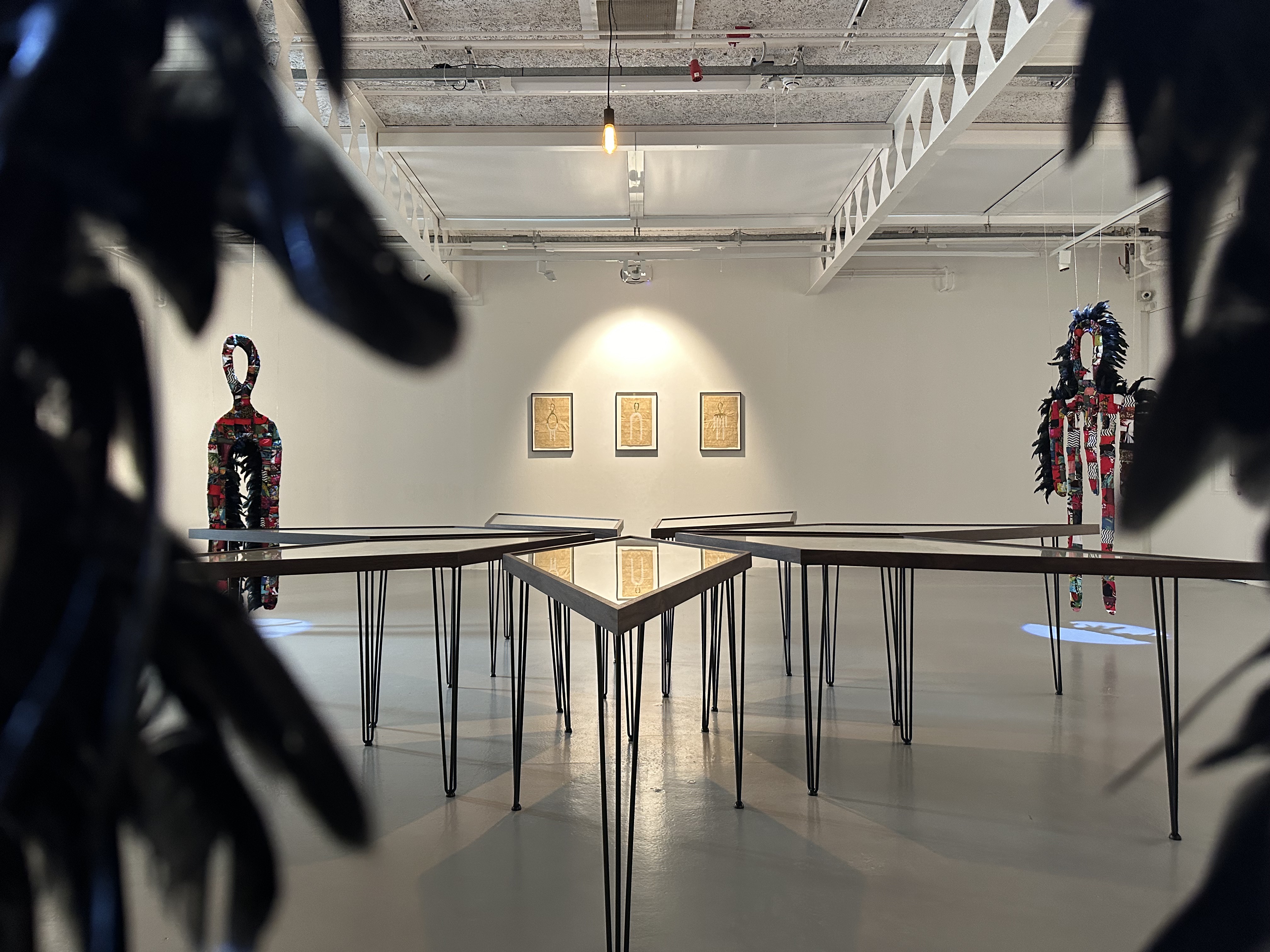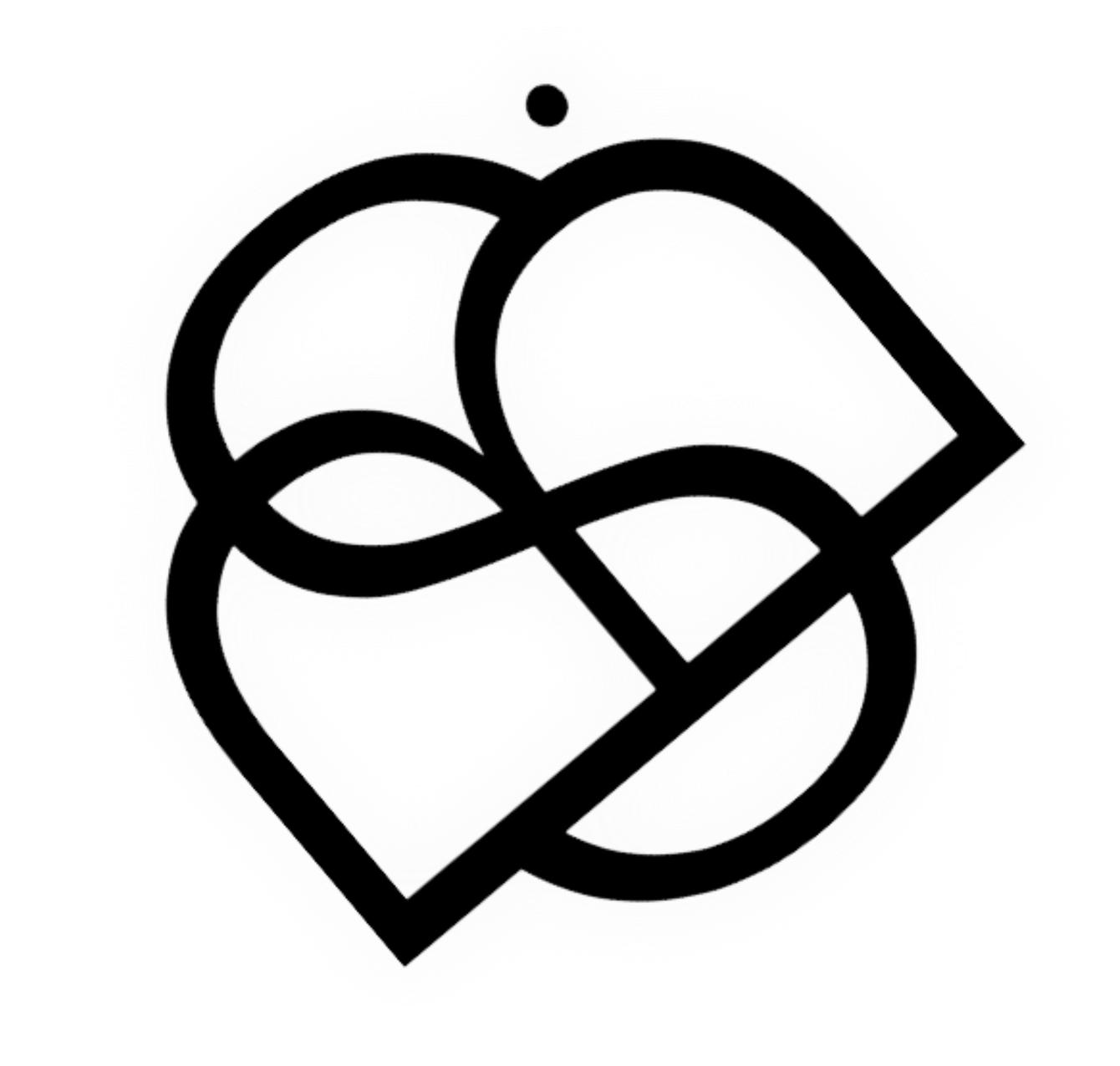Extended Exhibition Text
Written by Jane Scarth
![]()
‘Holding The Shadow While Calling Back The Light’ - Installation view at Herbert Read Gallery, Canterbury - Image courtesy of the artist - 2024
Benjamin Sebastian: Holding The Shadow While Calling Back The Light
This exhibition brings together work spanning over a decade of practice, with a brand new body of work alongside three sets of existing artworks. All the pieces present are in dialogue with one another to reveal enduring themes across Sebastian’s work - shadow and light, creation and destruction, esotericism, queer subjectivities and colonial heritages.
At the centre of Holding The Shadow While Calling Back The Light are three Entities, other-than-human sentinels surrounding a fragmented seven-pointed star - an emblem taken from the Australian flag. This star represents a deeply colonial principle - a point for each of the federated Australian states and territories, plus a seventh for any future states or territories yet to be named. An open ended possibility for settler-colonialism to claim and abscise more land, an implication that there is yet more violence still to come. The triplicate of non-binary Entities are constructed from a patchwork quilt of garments once belonging to the artist’s mother and fringed with black feathers. As guardians, their task is to keep watch over this dismantled colonial symbol - a false star - to ensure it will never again be re-formed.
Each diamond shaped star fragment is constructed from calico, a material used by Sebastian throughout the new body of work. Not only was calico a British colonial export from occupied India, but prior to their migration to Australia, Sebastian’s family lived in Oldham, one of the largest cotton milling towns in Britain. The fragments are adorned with prints of natural objects associated with transmutation or rebirth - shifting from one state of being to another - for example, a shedded snake skin, a chrysalis, a crow’s egg.
We encounter the Entities again in three wall based works where we are invited to study their forms more closely. These figures are other worldly beings from the spirit realm, who Sebastian has encountered and related with throughout their life. Crucially, these beings exist beyond gender, with forms that hold multiple appendages as well as openings. The geometric, patterned background of these works are formed from an abstracted British postage stamp bearing the profile of Queen Elizabeth II, one of several acts of iconoclasm appearing throughout the exhibition.
Presented alongside are seven textile works each constructed from a combination of calico and a deconstructed nylon Australian flag. These pieces are embellished with images of hybrid beings - homoerotic male bodies with heads of birds, snakes and butterflies, fusing together species native of Britain and Australia. Another piece in this series titled The Seemingly Innocent Are Not Without Danger features a family photo depicting the artist's grandfather surrounded by his sons, claiming and taming ‘their’ land, after their assisted migration from Oldham (UK) to Queensland shortly after the end of the 2nd world war. This government-sponsored scheme to encourage British migrants formed a significant part of the ‘White Australia’ set of policies, designed to engineer the erasure of the Indigenous population.
Complimenting these new works are three sets of earlier artworks. A series of four digital collages printed onto archival aquatints; Dead Queer Sex Fag (2023), which combine vintage gay porn with Victorian mechanical diagrams and fauna documentation. These works allude again to Sebastian’s family history within the industrial heritage of the north of England, juxtaposed with queer bodies. As the Victorians drove mechanical industrialisation they also applied a regime of order and categorisation - to name, to define, is to control and to oppress. As Foucault reminds us, the term ‘homosexual’ is a Victorian invention.
Sebastian’s expansive performance practice is presented across just two works. We encounter a large-scale diptych, photographic documentation of Phoenix (2013) in which the artist emerges from a burning paper structure. This work embodies the ritualistic power of fire, paired with the symbolism of death, transformation and emergence.
Alongside this, 3 Reflections² (2022) is represented through a single performance relic and video documentation of the three-hour durational performance presented at the Institute of Contemporary Art, London. In this work, Sebastian circulates between three stations, moving through a series of actions with props, including a mirrorball fetish hood and a crystal, chrome and chain-adorned body harness which disperses refracted light throughout the performance space. The power of words voiced - such as; ‘I called out and all that I heard was the echo of a star.’ - and the symbolism of light and shadow permeating this work provide a portal through which to enter many of the intertwined themes of additional works in this exhibition and beyond.
In Sebastian’s own words, ‘I experience the making of art as an act of (practical) magic. The parallels between artistic and occult practices are obvious to me, and I am fascinated by the potential of those practices in creating something from nothing – of drawing that which is yet to exist, into the physical material world. I understand such parallels as explicit links between not only occult and artistic workings, yet also neurodivergent and queer(ed) experiences and actioning of life. All are processes of manifesting something-not-yet-here/known.’

‘Holding The Shadow While Calling Back The Light’ - Installation view at Herbert Read Gallery, Canterbury - Image courtesy of the artist - 2024
Benjamin Sebastian: Holding The Shadow While Calling Back The Light
This exhibition brings together work spanning over a decade of practice, with a brand new body of work alongside three sets of existing artworks. All the pieces present are in dialogue with one another to reveal enduring themes across Sebastian’s work - shadow and light, creation and destruction, esotericism, queer subjectivities and colonial heritages.
At the centre of Holding The Shadow While Calling Back The Light are three Entities, other-than-human sentinels surrounding a fragmented seven-pointed star - an emblem taken from the Australian flag. This star represents a deeply colonial principle - a point for each of the federated Australian states and territories, plus a seventh for any future states or territories yet to be named. An open ended possibility for settler-colonialism to claim and abscise more land, an implication that there is yet more violence still to come. The triplicate of non-binary Entities are constructed from a patchwork quilt of garments once belonging to the artist’s mother and fringed with black feathers. As guardians, their task is to keep watch over this dismantled colonial symbol - a false star - to ensure it will never again be re-formed.
Each diamond shaped star fragment is constructed from calico, a material used by Sebastian throughout the new body of work. Not only was calico a British colonial export from occupied India, but prior to their migration to Australia, Sebastian’s family lived in Oldham, one of the largest cotton milling towns in Britain. The fragments are adorned with prints of natural objects associated with transmutation or rebirth - shifting from one state of being to another - for example, a shedded snake skin, a chrysalis, a crow’s egg.
We encounter the Entities again in three wall based works where we are invited to study their forms more closely. These figures are other worldly beings from the spirit realm, who Sebastian has encountered and related with throughout their life. Crucially, these beings exist beyond gender, with forms that hold multiple appendages as well as openings. The geometric, patterned background of these works are formed from an abstracted British postage stamp bearing the profile of Queen Elizabeth II, one of several acts of iconoclasm appearing throughout the exhibition.
Presented alongside are seven textile works each constructed from a combination of calico and a deconstructed nylon Australian flag. These pieces are embellished with images of hybrid beings - homoerotic male bodies with heads of birds, snakes and butterflies, fusing together species native of Britain and Australia. Another piece in this series titled The Seemingly Innocent Are Not Without Danger features a family photo depicting the artist's grandfather surrounded by his sons, claiming and taming ‘their’ land, after their assisted migration from Oldham (UK) to Queensland shortly after the end of the 2nd world war. This government-sponsored scheme to encourage British migrants formed a significant part of the ‘White Australia’ set of policies, designed to engineer the erasure of the Indigenous population.
Complimenting these new works are three sets of earlier artworks. A series of four digital collages printed onto archival aquatints; Dead Queer Sex Fag (2023), which combine vintage gay porn with Victorian mechanical diagrams and fauna documentation. These works allude again to Sebastian’s family history within the industrial heritage of the north of England, juxtaposed with queer bodies. As the Victorians drove mechanical industrialisation they also applied a regime of order and categorisation - to name, to define, is to control and to oppress. As Foucault reminds us, the term ‘homosexual’ is a Victorian invention.
Sebastian’s expansive performance practice is presented across just two works. We encounter a large-scale diptych, photographic documentation of Phoenix (2013) in which the artist emerges from a burning paper structure. This work embodies the ritualistic power of fire, paired with the symbolism of death, transformation and emergence.
Alongside this, 3 Reflections² (2022) is represented through a single performance relic and video documentation of the three-hour durational performance presented at the Institute of Contemporary Art, London. In this work, Sebastian circulates between three stations, moving through a series of actions with props, including a mirrorball fetish hood and a crystal, chrome and chain-adorned body harness which disperses refracted light throughout the performance space. The power of words voiced - such as; ‘I called out and all that I heard was the echo of a star.’ - and the symbolism of light and shadow permeating this work provide a portal through which to enter many of the intertwined themes of additional works in this exhibition and beyond.
In Sebastian’s own words, ‘I experience the making of art as an act of (practical) magic. The parallels between artistic and occult practices are obvious to me, and I am fascinated by the potential of those practices in creating something from nothing – of drawing that which is yet to exist, into the physical material world. I understand such parallels as explicit links between not only occult and artistic workings, yet also neurodivergent and queer(ed) experiences and actioning of life. All are processes of manifesting something-not-yet-here/known.’


